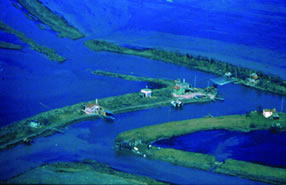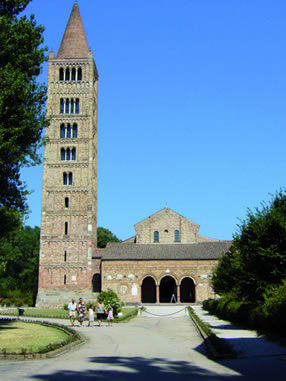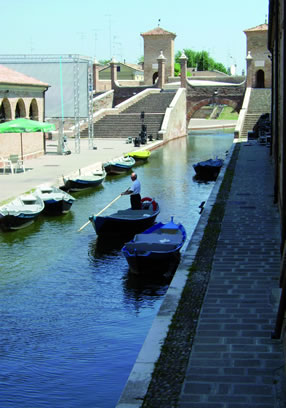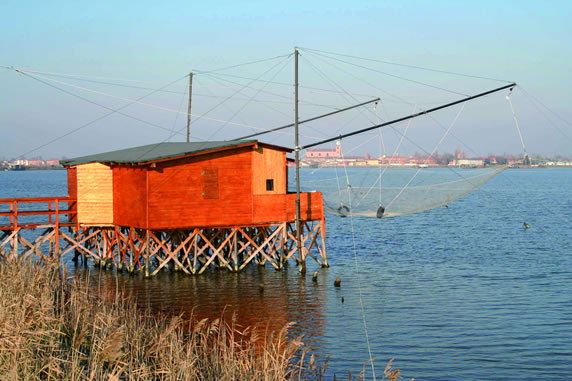It has such a history: human, economic, geologic, and innumerable branches. It has left everywhere traces and "remains" like the large river that, during centuries and millennia, has little by little pushed the Delta towards the sea, transforming coastal cities like Adria (giving its name to the Adriatic, which it overlooked with its port) in centres of the plains. The Delta, at the time of the Etruscans came down from the Adriatic more or less in the marshes of Comacchio and had its Greco-Etruscan capital, Spina, in Medieval times, and it enriched Ferrara and flowed into the sea with the branches of Goro, Volano, Caprasia and Eridano. In the twelfth century, in 1152, man created the Rotta Sicarda, in Ficarolo, which deviated the main branch of the river towards the Venice Laguna in the Po which is still called "of Venice".
At the same time pianura padana and lagoon, Emilian and Venetian, sum but not synthesis, between the two great medieval and Renaissance cultures, of Ferrara and of Venice, the Delta, as was written by Ruggero Orlando, is unity; and it is also unique: it does not resemble any other Delta of the great rivers of Europe, America, Africa, or Asia. It does not resemble any other Italian landscape; it offers something that no other vacation, no other place of residence offers: the unceasing mixture of country calm and the lively dynamics of the river.
The Delta of the "valli" and the reeds, of the "lavorieri", of the reclaimed and uncontaminated land, of the fish farmers' houses and lighhouses, of the old canals and streets (like Via Popilia, traced by the Romans in 132 A.C., and called Via Romea after Christianism), the Delta of which have written about Tito Livio and Stragone, Polibio and Plinio has to be, rather than described, "experienced" in all its aspects, wonderful and silent, and in its unexpected architectural reality.
The Grand Bosco della Mesola (the Delta's most famous natural beauty) is what remains of the great forrests destroyed by man through the centuries: there are over 400 arboreous species, and there live rare examples of fauna like the red deer, the fallow deer, and land and aquatic turtles. And, unexpectedly, at the foot of the levee appears the evocative and imposing complex of the village and the castle, built by Alfonso d'Este between 1578 and 1583, with its wide enclosure in masonry, the walls of the stables, and the square towers with crenels. A space without time that enraptures fantasy, anchoring it in history.
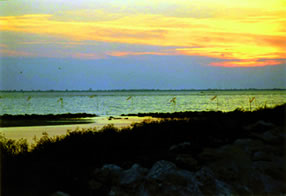
The church, from the IX century, has three apses and its bell tower is one of the Romanesque masterpieces of the XI century, with the large inscription of "Magister Deusdedit" dating as early as 1063.
The openings go from the simple embrasures on the lowest floor to the stained-glass windows and the twin and triple lancet windows of the sixth and seventh floors to the four arched windows of the last two floors. The whole construction is integrated from the remains of the ancient monastery and the Palazzo della Ragione, reconstructed, but original of the XI century.
If Ferrara and Rovigo are the two chief towns in the province of the Delta Padano, it is Comacchio that, out of thirteen small lagoon islands, comes out as the actual centre in which the Delta's atmosphere becomes tangible. One can feel it in the streets, on the bridges, the modest homes of the fishermen and the valuable architecture and monuments: I Tre Ponti, the palazzo Bellini, the cathedral of S. Cassiano, the seventeenth-century Loggia dei Mercanti (or the Grano), the Ponte degli Sbirri, the fish pond of the ‘700, the old neoclassic hospital S. Camillo.
From late Romanesque origin, Comacchio, flourishing in the Medieval times for fishing and salt trading, has become a dry land city following eighteenth-century drainage work. It is from here that we can leave, possibly on a boat, maybe on board of the Eridano, the Stradivari, the Amico del Po, made for comfortable excursions on the river, allowing us to see the two river banks and continuously changing panoramas, for a tour of the silent nature of the Delta which means immersing in old uncontaminated values and regaining possession of them.
